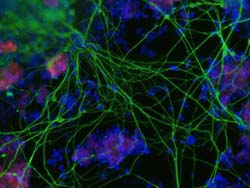Edinburgh scientists identify a key player in making specialised cells from embryonic stem cells

Mouse embryonic stem cells can be directed to become neurons (green) when grown in a dish…
Scientists from the University of Edinburgh have shown that the protein Mbd3 plays a crucial role in the process by which embryonic stem cells become specialised cells, such as brain or skin cells. These findings make significant advances in understanding how embryonic stem cells can be made to become all the different types of cell in the body, ultimately to be used in replacement therapies for specific diseases and injuries. This research is published online this week in the leading scientific journal Nature Cell Biology.
In the body, stem cells divide to produce both copies of themselves and other, more specialised, cell types. The Edinburgh scientists made mouse embryonic stem cells lacking the Mbd3 protein. Unlike non-engineered cells, the Mbd3-lacking cells failed to form different cell types when induced to do so in a dish, but rather remained in an uncommitted state. When injected into very early mouse embryos, the Mbd3-lacking cells behaved in a similar way, disrupting the normal development of the embryo.
Brian Hendrich, leading the research team, says “It is well established that embryonic stem cells need certain factors to sustainably make copies of themselves, that is, to self-renew. We have now shown, for the first time, that to leave that state and go down the specialisation pathway cells require the activity of Mbd3; it is not enough simply to remove the self-renewal factors. If Mbd3 is absent, the cells remain in an embryonic stem cell-like state”.
These latest findings will also provide insights into some of the crucial differences between mouse and human embryonic stem cells. Mouse embryonic stem cells need the protein LIF to be able to make copies of themselves indefinitely; human embryonic stem cells, on the other hand, do not need LIF to keep multiplying. Mbd3-lacking cells are similar to human embryonic stem cells in that they do not require LIF. They may, therefore, be used as a tool to understand how human embryonic cells bypass the need for LIF when multiplying without limit.
Mbd3 is part of a large complex of proteins called the NuRD (Nucleosome Remodelling and Histone Deacetylation) complex. NuRD is known as an epigenetic silencer, as its role in cells is to turn genes off.
This research was supported by The Wellcome Trust, the MRC and the BBSRC.
Media Contact
More Information:
http://www.iscr.ed.ac.ukAll latest news from the category: Life Sciences and Chemistry
Articles and reports from the Life Sciences and chemistry area deal with applied and basic research into modern biology, chemistry and human medicine.
Valuable information can be found on a range of life sciences fields including bacteriology, biochemistry, bionics, bioinformatics, biophysics, biotechnology, genetics, geobotany, human biology, marine biology, microbiology, molecular biology, cellular biology, zoology, bioinorganic chemistry, microchemistry and environmental chemistry.
Newest articles

High-energy-density aqueous battery based on halogen multi-electron transfer
Traditional non-aqueous lithium-ion batteries have a high energy density, but their safety is compromised due to the flammable organic electrolytes they utilize. Aqueous batteries use water as the solvent for…

First-ever combined heart pump and pig kidney transplant
…gives new hope to patient with terminal illness. Surgeons at NYU Langone Health performed the first-ever combined mechanical heart pump and gene-edited pig kidney transplant surgery in a 54-year-old woman…

Biophysics: Testing how well biomarkers work
LMU researchers have developed a method to determine how reliably target proteins can be labeled using super-resolution fluorescence microscopy. Modern microscopy techniques make it possible to examine the inner workings…





















